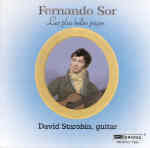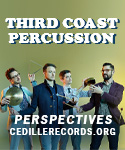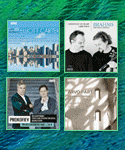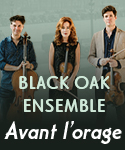I have to admit, I am not a fan of the guitar in the hands of any but a select few performers, and of these David Starobin heads the list. The reason is simple: he’s not just a guitarist, he’s a musician. I know that may sound tacky, but you have to ask yourself when listening to the 10 millionth guitar CD (and that’s a conservative estimate) what it is that the performer brings to music that more often than not barely gets past “ephemeral” on the interesting scale. Perhaps it’s because Starobin has spent so much time playing excruciatingly difficult (or is that just plain excruciating?) contemporary music, but he could make a guitar transcription of Satie’s Vexations sound appealing, and believe me, Sor was hardly vexatious. In fact, he was a very accomplished composer, as this well-chosen recital surely proves. I don’t know whether these particular works constitute Les plus belles pages, as advertised, in some objective sense, but as played here that’s just what they sound like.
The four studies (Nos. 2, 12, 17, and 23), as well as the Leçon No. 13 all sparkle. No. 17, which comes across as a jazzed-up version of the Quodlibet from Bach’s Goldberg Variations, is especially irresistible, its polyphony immaculately phrased and clean as a whistle. Nothing sounds mechanical or strained, and there’s remarkably little digital squeaking across the fingerboard in music that often sings more in the manner of a rusty hinge than with Sor’s particular brand of six-stringed bel canto. The Allegro moderato in E minor captures the Spanish flavor of a good Scarlatti sonata, while two Andantinos (in A minor and major respectively), the Cantabile in A major, and the particularly lovely Andante in D minor permit Starobin to demonstrate that it really is possible to achieve a true legato line on the guitar.
Of the two larger works, the Fantasie villageoise is especially evocative, with its bell imitations in harmonics and rustic ambiance. It concludes with a keenly imagined Prière, whose austerity and inward qualities Starobin judges perfectly, particularly in the way he subtly articulates the rhythm to keep the underlying pulse moving. Introduction et Thême Varié Op. 20 begins with a Larghetto prelude that (in this performance at least) has an aptly casual quality, strumming along the boardwalk, as it were, so when the perky principal theme finally arrives about three minutes in, it sounds as though it’s being improvised on the spot. The ensuing five variations build to a lively climax (with more ear-catching harmonics–don’t ask me why, but I really like harmonics) before ending graciously, with a gentle smile.
Here’s the bottom line: the music is mostly just plain fun, and so are these performances. I don’t have a huge Sor collection, nor does anyone who is not a guitar aficionado need one, but Starobin has persuaded me that I do need this disc in addition to what currently sits on my shelves, and if he should give us more (“The Only A Smidge Less Plus Belles Pages” perhaps?), I suspect I would need that one too. Adam Abeshouse’s ideally warm and clear sonics, along with very intelligent notes, provide the icing on the cake. And did I tell you that Starobin plays a timbrally exquisite 1923 Hauser guitar? And that he made me notice, and even care? Wonderful! [3/9/2005]
































